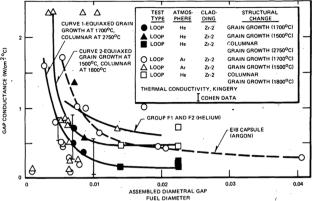Review of Thermal Gap Conductance Models and Measurement Approaches Toward an Understanding Beyond UO2 and Zirconium-Alloy Interfaces
Abstract
Heat transfer within a nuclear reactor is impacted by both the thermal properties of the individual materials (fuel, cladding) and the thermal conductance of the gap between the fuel and cladding. This gap distance changes over the lifetime of the fuel, and the associated variation in thermal conductance is important to the modeling and safe operation of nuclear reactors. This review article is intended to add to existing work by specifically discussing both modeling and experimental methodologies to determine the thermal gap conductance between two solid materials separated by gas as the structures of the materials change. The purpose of the review is to understand the limitations and benefits of each approach, both modeling and experimental, and to provide recommendations for future research directions for the nuclear materials community in developing an understanding of the heat transfer through gas gaps for accident tolerant fuels (ATF). The key takeaway from a review of the relevant models is that the ability to determine the thermal accommodation coefficient (TAC) by simulations aids in reducing uncertainty in experimental results. Coupling the TAC-determining simulations with multi-scale modeling approaches are necessary to understand many complex mechanisms affecting thermal gap conductance. The recommended experimental approach is either laser flash analysis or lock-in IR thermography because they are transient approaches that allow for more rapid measurements (compared to steady-state approaches) and are able to detect the range of expected thermal gap conductances (typically on the order of 1 × 104 W·m−2·K−1). Future research efforts focused on nanoscale modeling of the thermal accommodation coefficient coupled to engineering scale models would benefit the community. These models can then be verified by experiment measurements using the laser flash analysis or lock-IR thermography techniques.


 求助内容:
求助内容: 应助结果提醒方式:
应助结果提醒方式:


